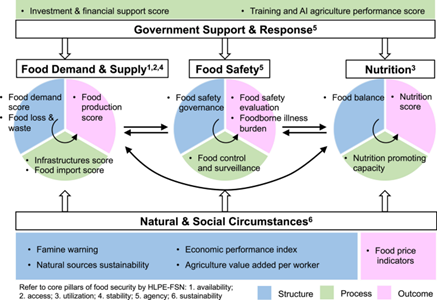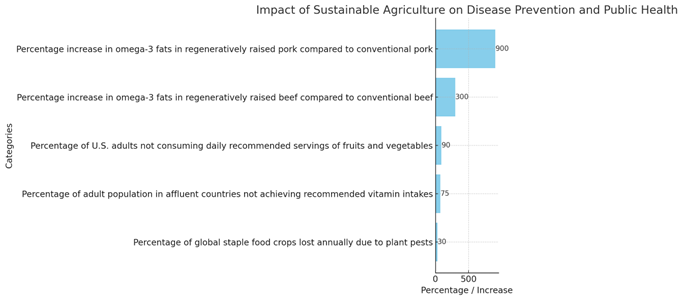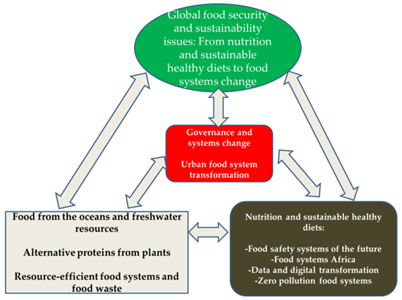Sustainable Agriculture and Public Health
I. Introduction
The public health implications of agricultural practices and the role of agriculture in the contemporary era of environmental changes, health crises, and food systems merit serious consideration. While nations endeavor to address the consequences of food systems on well-being, it is vital to cognize the role of the nutrition-sensitive agriculture system in transforming health outcomes. However, this is not the only aspect of this, as cultural values and policy levels significantly shape the way this phenomenon occurs. Among others, Norway exhibits how fragmented the agricultural policy goals can be, as they oppose with health promotion initiatives which at times lead to conflicting discourses along the lines of sustainability and nutrition (Allen et al.). Public spending in the agricultural sector as a part of national investment is health-promoting since it is substantially linked with economic growth. Hence, agricultural investments can realize substantial improvements in health outcomes within communities (WEOLEBO et al.). The close connections deduced from the results augment the overall discourse around sustainable agriculture and further align the systems therein towards future innovations that fulfill both ecological and health objectives.
A. Overview of the relationship between sustainable agriculture and public health
Modern debate is increasingly elucidating the complex relationship between sustainable agriculture and public health, revealing a substantial need for holistic approaches to effectively mitigate issues affecting both sectors. Regarded as an essential public health aspect, food insecurity spreads its effects to the psychological and general well-being domains due to the tight intersection of food availability and health outcomes, and its importance cannot be overemphasized (Chikezie et al.). Moreover, educational approaches such as One Health, which cover food safety and environmental concerns, require the integration of multiple disciplines to generate a more conscious society (Angelos et al.). Therefore, besides urban expansion and its corresponding challenge of the current food systems, urban agriculture and hydroponics system become potential remedies to ameliorate food security and public health. The emphasis of this paradigm shift is not only to eliminate hunger but rather to establish a food ecosystem that guards the health of individuals and the environment.
II. The Impact of Sustainable Agriculture on Food Security
Sustainable agriculture is arguably the most critical solution in tackling the global food crisis and is intrinsically tied to food security and public health issues. By adopting environmentally friendly practices accompanied by decreased prohibition of harmful pesticides, larger production rates can provide for dietary options that are also better for health. Sustainable agricultural models are not only significant for their multi-fold benefits, for example, pollination and widespread control of pests and also soil and water quality but equally contribute to crop resilience and nutritional quality. Moreover, this approach provides for the lowering of greenhouse gases and soil degradation, therefore, biologically ensuring agricultural production in the future (Hera et al.). The visual representation in underscores the fact interconnects between these agricultural systems, which translates to food security, thus highlighting the powerful connection between collaborative approaches to developing resilient food systems.
A. How sustainable practices enhance food availability and nutritional quality
Increasingly, sustainable agriculture and the success in enhancing food availability and nutritional quality are being connected to each other with a need for improved global public health and food security. This can be aided by applying methods that concentrate on biodiversity, soil health, and conservation of water resources and, at the same time, aiming at fulfilling or even surpassing the current yield demand. Hence, the nutritional quality of the produce is guaranteed or even improved. For example, the use of agroecology principles guarantees the development of food crops that are resistant against climate variabilities, and also minimizes the occurrence of global health problems like malnutrition and obesity (Committee UNSS on Nutrition). In addition, initiatives that target smallholder farmers’ access to value chains not only improve the local economy by creating job opportunities but also lead to healthy diets that are now made available to the population (Dorp et al.). It enforces the need for extensive adjustments in our practices if we are to promote better public health and food security through the use of sustainable methods of agriculture and down the line of environmental stewardess.
Image1. Framework of Food Security Components as per HLPE-FSN
III. The Role of Sustainable Agriculture in Disease Prevention
The interdependence of agricultural practices and community health is not becoming any clearer when it comes to infection prevention. Food insecurity can be decreased, and risks from the traditional style of agriculture can be reduced thanks to sustainable agriculture. This occurs when biodiversity is promoted, and chemical retention is minimized to minimize exposure with the public to pesticides and fertilizers that are harmful to their health, both at high levels and over the long term. We know from history that the One Health concept, which takes into consideration the impact of health concerns of humans, animals, and the environment, contributes to a rounded strategy to ensure a secure food supply (Angelos et al.). Definitely, the sustainable agriculture and climate adaptation strategies that get the attention of such vulnerable populations consequently help in addressing the health disparities.
This chart illustrates the impact of sustainable agriculture on disease prevention and public health. It depicts the percentage losses in global staple food crops due to plant pests and highlights the nutritional deficiencies related to vitamin intake and fruit and vegetable consumption among adults in affluent countries. Additionally, it shows the significant increase in omega-3 fatty acids in regeneratively raised beef and pork compared to conventional meat, emphasizing the benefits of sustainable practices.
A. The connection between agricultural practices and the reduction of foodborne illnesses
The role of agricultural activities in reducing foodborne diseases and the maintenance of public health has become a significant area of emphasis as foodborne infections are on the rise. By adopting scientifically sound agricultural techniques, not only are food production levels improved but also the exposure to foodborne pathogens in food products significantly drops. Among other things, implementing IPM (Integrated Pest Management) and organic farming methods enables the utilization of the dynamics of the natural ecosystem. As a result, dulled pest control chemical sprays are resorted to, which guarantee food safety. Moreover, strict hygiene measures at the point of collection and packing on the farm are believed to contribute positively to the prevention of contamination risks, and this implies that safe produce will be delivered to consumers. The One Health approach identifies education and policy-making processes as an integral part of developing food systems that ensure food safety and sustainability. Policy-making depends on a set of interdisciplinary works whose focus is on interconnectedness between health and environmental policies (Angelos et al.)(Hawkes et al.). In doing so, the agricultural sector can play a proactive role in maintaining public health through the reduction of foodborne transmittable microorganisms and parasites.
IV. Conclusion
Incorporation of sustainable agriculture as a public health strategy is becoming an increasingly essential approach to contemporary complexity in global challenges. If the agricultural sector is put into focus, public health success in terms of healthy nutrition and a lower prevalence of diseases can be attained, as shown by correlations discovered between agricultural investments and economic growth together with public health in regional areas such as sub-Saharan Africa (WEOLEBO et al.). However, making interdisciplinary efforts, hubs such as Wageningen UR, help us understand the complex nature of food systems in relation to human health (Eijsackers et al). Figure 2 presents a visual map of the food security, sustainability, and public health system, indicating systemic shifts advocated in the process, without necessarily adhering to natural laws. In the end, the synthesis of farmers’ assets and public health programs serves as the base for a healthy society whereby the citizens go through life with the sense of confidence that their future, both now and tomorrow, is secured.
A. Summary of the benefits of sustainable agriculture for public health and future implications
An important factor for the overall wellbeing, as interrelatedness between sustainable agriculture and public health can be, is society as a whole. Agriculture that is sustainable helps not only in the reduction of harmful pesticides and fertilizers but also, in turn, promotes the earth’s biodiversity, which leads to the water and soil health improvement. Such practices improve the nutritional value of the food basing on the current research that affirms the positive influence of the diverse diet on the human health and environmental resilience (Cogill et al.). Besides, the food insecurity and public health in the coming generations can be sustained by using sustainable approaches in the agriculture since climate change is affecting the yields in crop production. The dynamics of these two components has been pictorially represented in the figure 1, where the food systems oriented towards ecological integrity and human health are shown. Embracing sustainable agricultural methods by community members will culminate in the lowering of diet-related health issues that promote healthy people who are ready to face the future (Ranasinghe et al.).
Image2. Framework for Global Food Security and Sustainability Issues
Mirabelle Lu


